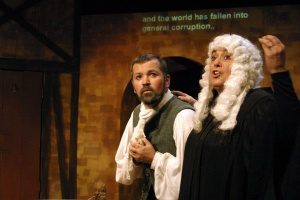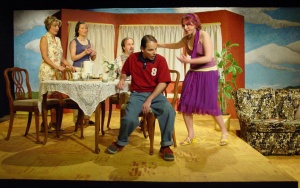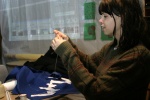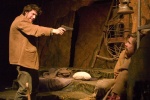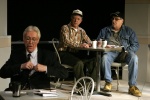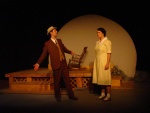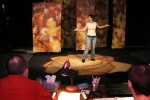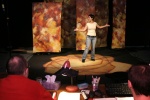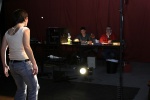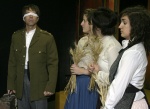La Troupe du Jour, Saskatoon’s Professional French-Speaking Theatre Company
par Forsyth, Louise H.
As its first French-speaking communities began to be established, Saskatchewan's first French-Speaking theatre company emerged at the beginning of the 20th century. But it has only been since 1985 that the province has had its very own professional French-speaking theatre company. La Troupe du Jour has taken upon itself to become a centre of artistic creativity in Western Canada. As a result, the group played a major role in the creation of a community of Fransaskois artists. Over the course of its existence, the company has staged a number of original works, as well as classics taken from the vast repertoire of French language literature. In 2003, La Troupe du Jour was inducted into the Margaret Woodward Theatre Hall of Fame.
Article disponible en français : La Troupe du Jour, théâtre professionnel francophone de Saskatoon
Presenting French-language Theatre in Western Canada
Amateur theatre was first organised by parishes and schools with the arrival of the first settlers in the early 20th century. University of Saskatchewan's Unithéâtre was the province's first French-speaking company. Under Ian Nelson's guidance, the company would focus on staging great French classics. 1985, La Troupe du Jour was created under the initiative of a group of former students (NOTE 1). The company first started as a Fransaskois community theatre. Since then, La Troupe du Jour has worked to ensure that each year's programme offers Saskatchewan's French-speaking and Francophile public a variety of quality plays, thereby giving Fransaskois comedians and authors a public stage and a voice. From its very first season, La Troupe du Jour has fulfilled the mission its creators had established for themselves: to promote the creativity, training, production and continuity of French-language theatre in Saskatchewan. As a result, the group became an accurate reflection of the Fransaskois' unique perspective on society. It managed to draw an interested public and quickly became community oriented - a characteristic which indicated that this theatre group had strong cultural roots in the Fransaskois community. La Troupe du Jour's performances also became opportunities for members of the community to socialise and work towards establishing a vibrant community. Furthermore, being a travelling theatre company, it has immersed itself in the diversity of the province's French speaking communities and takes an active part in the emergence of a unique brand of theatrical culture. La Troupe du Jour's success - after 23years of quality performances - is more than enough proof of this.
Early on, La Troupe du Jour gave itself the "mission of becoming the centre of theatrical creativity in Western Canada". Consequently, each season their programme offers at least one original play from an author from the Western provinces. La Troupe du Jour also supports playwrights by organising workshops, festivals and theatrical readings; by promoting the Cercle des Écrivains [The Writers Circle]; and by assisting with the publication of plays. These diverse activities are intended to offer direct assistance in promoting and the making the French language more widely known. It contributes considerably to the vitality and longevity of the French-language culture in Saskatchewan.
The company's tours of the province's schools are a vital part of its annual programme. In addition, it has two forums in which it interacts with the public. The first is the main theatre program, for which season tickets are available, generally features four productions: an original Fransaskois creation, a play chosen from among the repertoire of French, Quebec or international classics, a travelling show and at least one show for a younger audience. The second milieu is intended to be a meeting place for authors and is used as a platform for the provincial vocational training program, which provides services for community and school theatre companies. La Troupe du Jour also tours the many different localities of Saskatchewan. The company's induction into the Margaret Woodward Theatre Hall of Fame in November of 2003 (the first theatre company to have this honour) is evidence of the troop's professionalism and of its keyrole in the development of Fransaskois theatre and of French-language culture in Western Canada on a national and provincial level.
The Struggle to Find a Place to Call Home
Since day one, the people in charge of La Troupe du Jour have had to meet the challenge of finding permanent facilities and stage on which to perform. On twelve different occasions, the company has had to find new space for its offices and costumes, as well as for staging rehearsals and presenting its workshops. On nine different occasions it had to find a new place to stage its shows. These constant changes have been in constant conflict with the company's desire to maintain a regular audience and to strengthen its presence in the Fransaskois community. Nevertheless, the members of this courageous theatrical troupe continue to face this considerable challenge.
The troupe's first productions were presented on various stages. It settled into its first facilities in 1987, but had to leave the following year because of a lack of funding. This first theatre was actually a former funera lhome which had a low ceiling. Its gloomy atmosphere inspired them to name it the "Théâtre Bas-Côté [The Skid RowTheatre]". Despite having now moved into a new building, they hope to keep the name chosen twenty years ago. Improved finances have allowed for La Troupe du Jour to move into their second "Théâtre Bas-Côté" in 1990. That same year, Denis Rouleau's arrival as artistic director enabled them to become a professional theatre company (NOTE 2). Unfortunately, a new set of financial problems surfaced in 1996. This meant the troupe had to leave their newly established stage and share a series of more modest facilities with various other small Saskatoon theatre companies. Today, La Troupe du Jour stages its shows in a church hall in the Broadway District. Despite certain inconveniences, this facility offers theatre in a public space already familiar to the inhabitants of Saskatoon.
The future now seems brighter: in 2006-2007 a feasibility study showed the viability of a project that would offer permanent professional space for quality theatre productions. It would include: a rehearsal hall, wardrobe space, space for costume and set design, storage space and office space. In 2007, the announcement of a fund raising campaign was made under the theme of‘passion' and ‘perseverance', necessary qualities for the realisation of the project and attributes that members of LaTroupe du Jour have never lacked. The French-speaking and Francophile community will be enriched by the theatre production centre the troupe hopes to build. Furthermore, it will contribute to Saskatoon and the province's cultural diversity.
A Program Reflective of the Community's Cultural Diversity
Since its beginnings in 1985, La Troupe has presented more than 80 theatrical productions to the public, of which around forty are original works, totalling more than 700 showings. The group needed to ensure that it could offer a varied program, while keeping in mind the various levels of mastery of its public had of the French language, as well as the diversity of their cultural backgrounds.The public audiences include Saskatchewan-born French-speakers, as well as individuals coming from Acadia, Quebec and from other Canadian provinces. Some even come from other French-speaking countries.
This diversity is also found among the creators. Saskatchewan-born Laurier Gareau is a talented playwright, journalist, stage director and historian by profession. On a regular basis, he has also been actively involved in the troupe's various projects from the very earliest years. Gareau, like his sister Adrienne Sawchuk and playwright Madeleine Blais-Dahlem, owes his initial training and schooling to Saskatchewan's religious communities. His sister is an actress and writer of radio plays while the Blais-Dahlem is a playwright whose works ,such as the 2008 showing of "Les Vieux Péteux [The Old Farts]" have been performed by the troupe. New French works being in frequent and often almost entirely unavailable in a milieu largely dominated by English-speakers, these productions help to promote French-language culture. It allows young people and adults alike to maintain a vibrant relation with their culture and their language.
The production of the final version of Laurier Gareau's La Trahison [The Betrayal] (1995) was a turning point in La Troupe du Jour's history because it helped nourish and encourage reflection on the relations between the community and the Catholic Church. This play follows the tragic events of Batoche in 1885 and severely criticises the Catholic Church's part in the defeat of the Métis. With this play, Laurier Gareau breaks with convention and offers a fresh and penetrating perspective of the history of the province's French-speakers and the Métis. In 2007, the company also produced the spectacular "Deux Frères [Two Brothers]" by David Baudemont, a French geologist and recent Canadian citizen. It is an original work that reflects the great diversity of French-speaking authors in Saskatchewan.
La troupe du Jour draws a remarkably diverse public. Among them are numerous French-speakers as well as Francophiles, whose comprehension of the language varies from person to person. It is therefore understandable that note very spectator will deeply appreciate the various stories and stage techniques or respond to the diverse themes and levels of language in the same way.
Each year, in order to face that challenge, the troupe needs to offer a program that will please a mixed audience, by making good use of the stage and the sets at its disposal - in addition to finding the necessary resources to meet with this challenge. Year after year this remarkable team rises to the challenge and, as a consequence, their shows almost always sold out.
A Theatrical Approach to Promoting the French Language
This success is largely due to the talent and devotion of Denis Rouleau, La Troupe du Jour's artistic director, who has been on staff since 1989. It is his work that has enabled this extraordinary company to develop and continue to maintain its high artistic standards and infectious creative energy today. Rouleau himself has also been able to profit from the unique challenges faced by a French language based theatre based in Saskatchewan. These challenges include: casting, set design, management and language negotiation in the workplace. Under his direction a dynamic, almost visionary, company has emerged.
With the years, the company has created a vast range of new stage techniques, playing on bilingualism without making any artistic compromises. Methods used by Rouleau and his colleagues intended to deal with the considerable challenges they face are simple and efficient. These methods are appreciated by the public and ensure effective communication. They include: exercises in body language, characters being played by two actors, use of props rich with connotation, astonishing repletion of scenes, the breaking down the boundaries of the stage and the use of lighting and music. These modest methods create unexpected results.
Rouleau always avoided taking the easy way, while favouring stage efficiency. In 2007-2008, in order to broaden the scope of the audience, La Troupe du Jour introduced a system of subtitles, which enables English-speaking husbands, wives, girlfriends and boyfriends to attend the plays without losing too much of the play's content. La Troupe du Jour's ups and downs were became fresh occasions for introspection on what is truly essential vs. what is disposable when creating theatre. The harsh working conditions the troupe had to face have transformed the company into a sort of laboratory in the fields of drama, acting, set design and language.
The Cooperative Spirit: a Very Productive Necessity
It is important to point out that La Troupe du Jour would never have been able to achieve all it did to promote theatrical creativity, had it not had the help of Fransaskois creators and playwrights such as Laurier Gareau, Raoul Granger, Ian Nelson, Adrienne Sawchuk, etc. One must also not forget the company's capacity to collaborate with other theatre companies from the West, whether from the English or French communities. The group has been in close collaboration with French-language companies such as: La Compagnie Oskana of Regina, Le Cercle Molière of Saint-Boniface, L'UniThéâtre of Edmonton and La Seizième of Vancouver. In Saskatoon, whenever it was possible, the troupe also shared the stage, equipment and costumes with English-speaking companies: Persephone Theatre, 25th Street Theatre, Shakespeare on the Saskatchewan and the Saskatchewan Native Theatre Company .Furthermore, playwrights associated with La Troupe du Jour have greatly benefited from contacts and connections established with the Centre des Auteurs Dramatiques of Montreal. La Troupe du Jour has adopted the collaborative model established by the Centre des Auteurs Dramatiques, which brings playwrights and other people interested by writing plays together. This collaborative modal involves having a text read out loud (often by professional actors) at every step of the writing process, staging public readings; encouraging exchanges and translations; and preserving manuscripts and documents associated with these creative works. This resulted in the creation of a community of artists that otherwise would have never existed.
Saskatchewan's citizens are people who love living, laughing and crying, working on artistic projects, reflecting on what goes on around them, exploring universal questions, expressing their essential freedoms and liberties, as well as safeguarding their shared memories - without being slaves to it. These are people for whom horizons are broad and it is this outlook on life that is reflected in La Troupe du Jour's shows.
The publication of some of their creative works ensures their art will remain alive in a province where, in 2008, just over 1,5% of the population considered themselves to be French-speakers (NOTE 3). What is encouraging is that there is a new generation of actors, stage directors, musicians, set designers and playwrights emerging, who are always ready to take part in ongoing projects. La Troupe du Jour offers an excellent basic training to those who wish to pursue a career in theatre.
Not only did La Troupe du Jour create a large Fransaskois theatrical repertoire, it was also able to establish close relations with artists of the Fransaskois community. As a result of its collaboration with other English-speaking companies, La Troupe du Jour has also come to play an important role in keeping Saskatchewan's theatre alive and well. All these activities work to ensure that French-language will not be marginalised, but rather it will remain fully integrated into the province's artistic network and continue to develop a variety of bilingual theatrical initiatives. The troupe has also put together an impressive quantity of theatre archives (NOTE 4)detailing its history, thereby helping to preserve Fransaskois cultural heritage and keep the community's shared memories very much alive.
Louise H. Forsyth
Professor Emeritus
University of Saskatchewan
NOTES
Note 1. University of Saskatchewan's Unithéâtre was founded by Ian Nelson and a few students. In 1985, they chose Jean-Paul Sartre's Huis clos for their first show. Still today, Ian Nelson - librarian, actor, stage director, and translator remains the mainstay of LaTroupe du Jour. He also founded the Cercle des Écrivains [The Writers' Circle] of which he is the theatrical advisor.
Note 2. As these words are being written, Quebec-born Denis Rouleau is still La Troupe du Jour's artistic director. It is certainly due to his many talents, creative energy, devotion and courage that La Troupe du Jour has been able to stay on course so admirably and take its place as a permanent professional theatre company in a province where about 1,5% of the population speaks only French and little more than 5% speaks both French and English.
Note 3. According to the 2006 census from Statistics Canada.
Note 4. See the concise bibliography for the titles of some of the texts written by La Troupe du Jour.
BIBLIOGRAPHY
Anon., Le théâtre fransaskois. Recueil de pièces de théâtre. Tome 1, Regina, Les Éditions de la Nouvelle Plume, 2006 (contient De blé d'inde et de pissenlits de Lorraine Archambault, Le mariage de la fille Gareau de Raoul Granger, Il était une fois Delmas, Sask... Mais pas deux fois! by André Roy, with the collaboration of Claude Binet).
Beaulieu, Anne-Marie, "La Troupe du Jour présente: Deux frères", L'Eau vive, vol. 36, no 6 (February 15th, 2007), p. 9.
Beaulieu, Anne-Marie, "Deux frères. Un spectacle réussi", L'Eau vive, vol. 36, no 9 (March 8th, 2007), p. 12.
Blais-Dahlem, Madeleine, Les vieux péteux, (unpublished final édition, 18/02/07, 67 p.).
Blais-Dahlem, Madeleine, Foyer. Le théâtre fransaskois. Recueil de pièces de théâtre. Tome 2, Regina, Les Éditions de la Nouvelle Plume, 2007. 121-167 (this edition also includes: 5 ans by David Baudemont, Le costume by Raoul Granger et Mis à part by Guy Michaud).
Collectif, L'R libre, Théâtre et contes urbain, Saint-Boniface, Les Éditions des Plaines, 2002.
(includes Le cadeau by Gérard Ducasse, La grande gravité by David Baudemont, L'étrange aventure by LaurierGareau, Les chemins de la mémoire by Marie-Pierre Maingon, Foyer by Madeleine Blais-Dahlem, Le bal (tale) by Raoul Granger, Les coquelicots de Sarajevo by Hilda Ducasse).
Forsyth, Louise, "Les enjeux d'une pratique théâtrale et dramaturgique francophone à Saskatoon. Notes pour un historique d'Unithéâtre et de La Troupe du Jour", Revue historique, vol. 11, no 1 (October, 2000), p. 1-10.
Forsyth, Louise, "La Troupe du Jour de Saskatoon: une compagnie-laboratoire", in Hélène Beauchamp et Joël Beddows (dir.), Les théâtres professionnels du Canada francophone. Entre mémoire et rupture, Ottawa, Le Nordir, 2001, p. 135-150.
Gareau, Laurier, "Le festival théâtral Zone. Oyé! Oyé! Fransaskois", Revue historique, vol. 17, no 3 (March, 2007).
Gareau, Laurier, Joe Bolduc, Private Eye. Quatre pièces pour adolescents, Regina, Les Éditions de la Nouvelle Plume, 2002 (includes Les aventures de Joe Bolduc, Private Eye (1987), Le bad guy et la veuve (1989), Un Moose Jaw vaudeville (1990), Un nerd comme moi (1989)),p. 43-69.
Gareau, Laurier, "Postface", dans Le théâtre fransaskois. Recueil de pièces de théâtre. Tome 1, Regina, Les Éditions de la Nouvelle Plume, 2006, p. 151.
Gareau, Laurier, La trahison, Regina, Les Éditions de la Nouvelle Plume, 2004.
Gareau, Laurier, "The Betrayal", dans Nancy Bell (dir.), 5 from the Fringe, Edmonton, NeWest Press, 1986.
Nelson, Ian, "Préface", Le théâtre fransaskois. Recueil de pièces de théâtre. Tome 1, Regina, Les Éditions de la Nouvelle Plume, 2006, p. I-II.
Additional DocumentsSome documents require an additional plugin to be consulted
Images
Documents PDF
-
 La Troupe du Jour au Margaret Woodward Hall of Fame
La Troupe du Jour au Margaret Woodward Hall of Fame
-
 Pièce : L'Amour, a en mourir de peur !
Pièce : L'Amour, a en mourir de peur !
-
 Théâtrographie de la Troupe du Jour, 1986-2006
Théâtrographie de la Troupe du Jour, 1986-2006

![‘Les Vieux Péteux [The Old Farts]’, 2008](/media/thumbs/472/300x200-TDJ_VieuxPeteux.jpg)

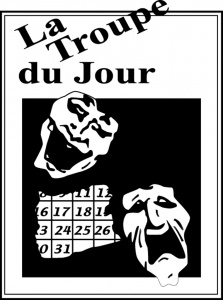
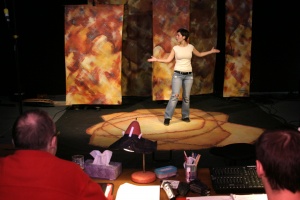
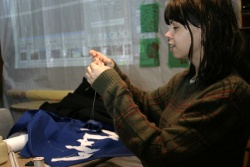

![“Deux Frères [Two Brothers]”, 2007](/media/thumbs/1062/300x200-TDJ_Deux_freres.jpg)
